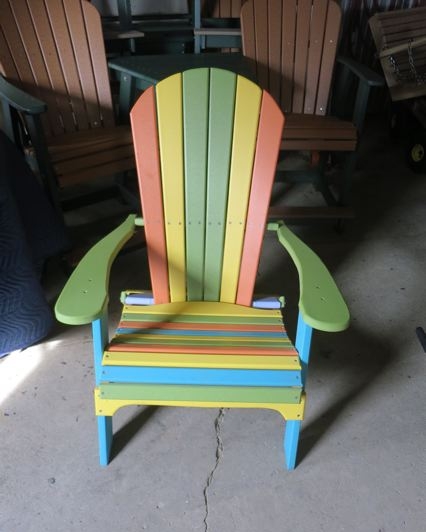How are Amish dealing with the recession?

Technically, I believe we are not in a recession anymore (though try telling that to any of the 10%+ unemployed, or those that have simply given up looking for a job and are no longer counted in that statistic; on that count it looks like the new buzzword to describe the current situation is “human recession”), but I just read a story about how Amish businesses are also impacted by tougher economic times.
The piece looks at a New York Amish furniture store, and basically makes the point that a combination of higher input costs for producers, and consumers with less in their pockets, have caused a slowdown in business.
The general slowdown in the furniture and building industries has been going on for awhile, and Amish businesses on the whole do not enjoy the boom times they once did.
Yet still you see examples of Amish entrepreneurs doing quite well, and business failures remain infrequent. Last summer, with unemployment reaching new highs month after month, I caught up with a furniture maker friend in Ohio, who appears in my book under the name ‘Alvin Hershberger’. Alvin claimed that his business was on fire.
Well, not literally, but orders were apparently pouring through the doors. Alvin is an example of a fairly aggressive and marketing-savvy entrepreneur, and I know his approach probably has helped him, as well as his focus on making the most of high-impact sales venues such as trade shows. His furniture is well-made and high-quality, but does not occupy the high end of the market (as opposed to that of some other furniture makers in his area).

I spoke with a Pennsylvania Amish builder friend recently who also appears in my book. He shared that his business has begun picking up lately, and had even landed a couple of new construction projects (previously he had been focusing solely on remodeling–with the smaller financial outlay involved, remodel work is typically more common than new home construction in tougher economic times).
Trying to get a feel for whether he is an outlier or not, but it seems that things may be looking up a bit, at least going by this anecdote and his impression of the industry. He seems a lot more optimistic than one year, or even half a year ago.
Another Amish friend and business owner I also spoke with recently is in a business that’s maybe not quite recession-proof, but close. He sells Plain clothing, not just to Amish but to Old Order Mennonites, Hutterites, and even Orthodox Jews. He is apparently coming off of his best year ever and was excited to talk to me (and vice versa of course!).

His is an example of what Kraybill and Nolt call a “segregated” business, one which deals primarily within his own culture (versus an “integrated” enterprise, such as furniture or market stands, which are typically more closely tied to the outside non-Amish economy).
With the number of Plain bodies that need well-fitting clothing increasing from year to year (and with those bodies themselves continuing to grow), providing Plain clothing is definitely what you might call a “growth” business.
On the whole, some Amish businesses are having a harder time of it than others, but since Amish firms typically do not carry high levels of debt, and tend to have low operating costs, they are often better-positioned to ride out tough economic times like the ones we are experiencing now.





It’s interesting to hear that Plainclothing is a growth industry. It’s not only the Old-Orders who buy it. As youmight know from my blog, there is a substantial and gorwing group of Plain dressing people outside the traditional Anabaptist groups. Many did not grow up in Plain communities, so need some direction in dressing Plain, buying Plain, and mostly, living Plain. Amish America helps with that, certainly! Many of us new-Plain people don’t have the sewing background or perhaps the time to produce our own clothing, andlook to outside vendors. We often exchange information on good vendors.
Thanks for the new website and info. I know an Alvin Hershberger in Ohio–will soon be reading you book!
Best of luck to you.
Hey Magdalena, thanks a bunch, and I did notice that from your blog. It is an interesting trend and a positive one. Learning sewing would be a challenge, at least it would for me.
Giving Amish pseudonyms in books
One of the first few pages of my book is a note on names which explains why I chose to ‘rename’ the Amish in my book (typical issues of pride and avoiding the spotlight, etc). When I was going through the process of choosing ‘pseudonyms’, sometimes one would come to me immediately, and I just knew it ‘fit’ the person, and other times it would take me a while to come up with one. ‘Alvin’ was from the second category. It took me a while to think of one that ‘fit’ the person I had in mind. But somehow ‘Alvin’ definitely fits him.
But the actual ‘Alvin’ (if I could say his real name, that would make my explanation easier of course, but need to stick to the confidentiality clause here), who’s read a draft part of the book, loves it, and when we ring him up I’ve gotten to calling him by his pseudonym as a bit of a joke, with a lot of laughs of course. In fact come to think of it I’ve had a similar experience with another Amish contributor who seems to quite like his new moniker as well.
I guess having a second name might be kind of fun, and I’m looking forward to the reaction when my contributors read their words under their new names!
And Ann, thank you.